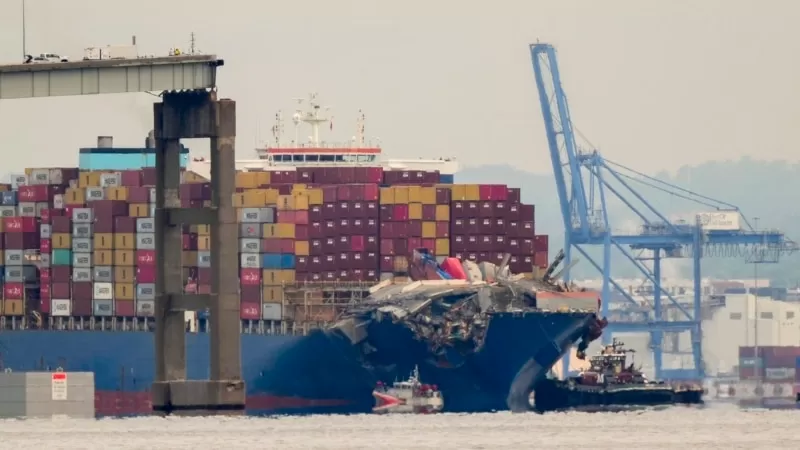Baltimore, a bustling port city on the East Coast of the United States, has been making headlines recently due to a tragic incident that occurred on March 26. A container ship, named the Dali, lost power and crashed into one of the supporting columns of the Francis Scott Key Bridge, causing its collapse. The disaster claimed the lives of six construction workers and halted most maritime traffic through the port. However, after nearly two months of intense cleanup and recovery efforts, there is finally some positive news to report.
On Monday, the Dali was successfully refloated at high tide and began slowly moving back to port, guided by several tugboats. This marked a significant step in the ongoing efforts to remove the wreckage and restore normalcy to the port. The vessel, which had been grounded at the collapse site since the incident, appeared to start moving shortly after 6 a.m. It took a few starts and stops, but eventually, the ship slowly and steadily backed away from the site.
The Dali’s bow was still covered in mangled concrete from the collapsed roadway, with pieces of the bridge’s steel trusses protruding from it. However, with the ship finally removed from the mouth of Baltimore’s harbor, a newly opened void appeared in the city’s skyline. The altered waterscape also highlighted the progress made on the cleanup effort, with hundreds of tons of mangled steel already removed from the water’s surface.
In recent weeks, the bodies of all six construction workers have been recovered from the underwater wreckage. It is a tragic loss, and our hearts go out to their families. The victims were all Latino immigrants who came to the U.S. for job opportunities and were filling potholes on an overnight shift when the bridge collapsed.
Officials have stated that the Dali will move at a speed of about 1 mph on its roughly 2.5-mile journey back to port. This is a fraction of the speed it was traveling when it lost power and caused the bridge to collapse. The ship is expected to remain in the port for several weeks and undergo temporary repairs before being moved to a shipyard for more substantial repairs. It will return to the same marine terminal it occupied before its ill-fated voyage.
The preparations for refloating the ship began about 18 hours before it started moving on Monday morning. This involved releasing anchors and pumping out over 1 million gallons of water that were keeping the ship grounded and stable during the complex cleanup operations. Additionally, a controlled demolition was conducted on May 13 to break down the largest remaining span of the collapsed bridge, which was draped across the Dali’s bow. Dive teams also completed inspections of the site to ensure there were no obstructions that would hinder the voyage.
According to a preliminary report released last week by the National Transportation Safety Board, the Dali experienced two electrical blackouts about 10 hours before leaving the Port of Baltimore on its way to Sri Lanka. In response to these issues, the crew made changes to the ship’s electrical configuration, switching to a transformer and breaker system that had been out of use for several months. Unfortunately, the ship experienced two more blackouts as it was approaching the Key Bridge, causing it to lose propulsion and drift off course at the exact wrong moment.
The two tugboats that helped guide the Dali out of the port had peeled off after it entered the main shipping channel, which is standard protocol. However, when the power went out, the tugs were too far away to help avert disaster. The FBI has launched a criminal investigation into the circumstances leading up to the crash, and we hope to get some answers soon.
Since the disaster, the ship’s crew members have not been allowed to leave the vessel. They have been busy maintaining the ship and assisting investigators. Of the 21 crew members, 20 are from India, and one is Sri Lankan. Officials have stated that they will be able to disembark once the Dali is docked in Baltimore.
The port’s 50-foot deep draft channel is expected to reopen by the end of May. Until then, a temporary channel has been established, which is slightly shallower. We are confident that with the progress made so far, the port will soon be fully operational again, and Baltimore’s economy will bounce back stronger than ever.
In conclusion, the refloating of the Dali is a significant milestone in the cleanup and recovery efforts after the tragic collapse of the Francis Scott Key Bridge.

